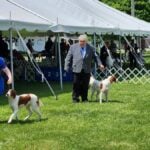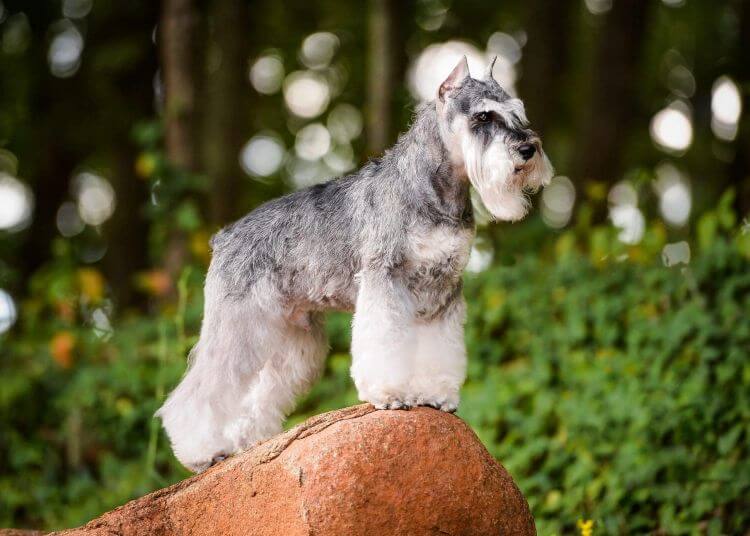
Home » Square, Short, and Straight: Judging the Miniature Schnauzer

What to consider when judging the Miniature Schnauzer. The square, short, and straight Miniature Schnauzer is one of just a few Terriers that did not originate from the British Isles. Developed in the Bavarian region of Germany in the late 1800s, the Miniature Schnauzer appears to be a cross between smaller Standard Schnauzers and the “Monkey Pinschers” (today’s Affenpinscher) common in that area. As with the British Terriers, the multi-purpose Miniature Schnauzer was bred to be a ratter, with the bonus of being a watchdog and a great family companion.
The statement of General Appearance describes both his function and his general appearance: “The Miniature Schnauzer is a robust, active dog of terrier type, resembling his larger cousin, the Standard Schnauzer, in general appearance, and of an alert, active disposition.” Note that our breed standard describes a general resemblance, not a miniature copy of the Standard Schnauzer. The three Schnauzers are three distinct breeds with three distinct breed standards.
Watching Miniature Schnauzers walk into your ring, you should see distinctive dogs with hard wiry coats in one of three accepted colors. Look for the square, sturdy outline, rectangular head with clean cheeks, ears cropped or uncropped, strong well-arched neck, short deep body, straight backline that declines slightly to a flat croup with a docked erect tail, and a hard wiry coat. Get a first impression of size; whether each dog is within the size range of 12” to 14” regardless of age or sex.
Let the dogs move around the ring to loosen up, and start your examinations on the table. A quick word to the dog will make sure that he is paying attention, then a hand under his chin. You are looking for the head to be strong and rectangular with flat, clean cheeks. With the short-faced Affenpinscher in our history, our standard carefully states that the muzzle is “at least as long as the topskull” which is “flat and fairly long” and “ends in a moderately blunt manner.” In practice, this means the muzzle should be approximately the same length as the topskull—neither shorter nor exaggerated and too long; balanced. Overall impression is rectangular, strong but not blocky, nor too narrow; parallel planes.
Lift the eyebrows to make sure eyes are small, dark, oval, and deep-set. Think of dark walnut for color. Nose color must be solid black, any other color is a DQ. Teeth; scissors bite only, look for six upper and lower incisors. To check bite, hold down the center of the beard below the teeth with your left hand and, with your right, use your forefinger and thumb on each side of the incisors to slide up the upper lip. Please do not go picking through the beard looking for side teeth. Ears; cropped or uncropped is optional in our breed standard. If cropped, the ears should be balanced and set high, with the inside edges carried perpendicularly. When uncropped, the ears are small and V-shaped, folding close to the skull, the tip pointing to the outside corner of the eye. Look for the “use of ears” on the ground, not on the table. The Schnauzer’s characteristic “down the nose” expression is emphasized by trimming the eyebrows into a sharp triangle. The beard will be trimmed and shaped to emphasize the rectangular shape of the head.
Overall body outline is square, measured from the forechest to buttocks and withers to the ground. Look for robust and sturdy. The brisket extends at least to the elbows, ribs well-sprung and deep, loin short.
Forequarters should be straight and parallel; strong pasterns; good bone. Neck strong and well-arched, blending into the shoulders. Sloping shoulders, well-laid back. Look for a smooth transition from the neck into the shoulders and topline; neck should not be short and stuffy. Viewed from the side, the forelegs should be set back slightly, but not so much that the sternum (or chest bone) protrudes obviously.
Short round (cat) feet. Hindquarters have strong muscled thighs…never overbuilt or higher than shoulders. There should be “dog behind the tail,” a little “shelf.”
The backline is straight, sloping slightly to the base of the tail; flat croup—no roller coasters. Read carefully the breed standard on Tail: “Set high and carried erect. It (tail) is docked only long enough to be clearly visible over the backline of the body when the dog is in proper length of coat. A properly presented Miniature Schnauzer will have a docked tail as described; all others should be severely penalized.” The American Miniature Schnauzer Club is NOT one that says “whatever” when it comes to tails. This is breed type, this is recognizing our breed. AKC expects judges to move and examine every entry. “This includes breeds that according to their breed standard traditionally have been cropped and/or docked and dogs entered which may have deviations from the breed standard.” So, after moving and examining that dog with a deviation such as an undocked tail, we expect you to respect important attributes of breed type as written in our AKC breed standard. An undocked tail should be considered a serious enough fault as to effectively remove that dog from conformation competition at an AKC show. We’re serious.
Judging the Miniature Schnauzer – Disqualifications: Dogs or bitches under 12 inches or over 14 inches. (any age or sex), but also keep in mind that there is no preferred size; anything within that range is correct as long as you don’t see toy-ishness, ranginess or coarseness. Please measure if you have any questions. It can be very difficult to visually discern a critical ¼ inch. It is much better to be certain rather than make the mistake of putting that (perhaps) oversized but otherwise lovely dog at the end of the line. Size is a DQ, and we need your support in the ring.
Judging the Miniature Schnauzer – Coat: Double Coat; hard, wiry outer coat, close undercoat. Texture is the most important thing. As with some of the other Terriers, it doesn’t matter whether the exhibitor has “stage stripped” or “rolled” the coat. The most important thing about coat is that texture on the day should be hard & wiry. To extend the coat in show condition, varying amounts of undercoat may have been raked out. Coat on the head, neck, chest, tail, and body must be plucked; the throat, cheeks, and bottom will be clippered; leg furnishings, beard, and eyebrows will be scissored. Coat length is not stipulated; must be able to determine correct texture.
Judging the Miniature Schnauzer -Colors: Allowed colors are Salt & Pepper, Black & Silver, and solid Black. Black is the only solid color allowed; a small white spot on the chest or occasional white body hairs are permissible. The Salt & Pepper coat consists of a mixture of solid black, solid white, and banded hairs, varying from light to dark, tan shading permitted. The Black & Silver coat is the same bi-color pattern, except solid black where the salt & pepper would be, and with the difference that the underbody furnishings below the chest & ribcage should be dark. Judging: Watch for any white (even a narrow blaze) in colored area mid-forechest between the silvery white “bow tie” and lighter area of the throat—it’s a DQ.
Judge movement at the trot. Look for the good reach and drive of a square-built dog; no mincing, no prancing, no chin tapping front or high kicking rear; true double tracking coming & going. At a full trot, there will be a slight inward inclination beginning at the shoulder in front, and the hip in the rear, but no excuse for moving too close or crossing over.
Judging the Miniature Schnauzer – Temperament: “alert and spirited, yet obedient to command…friendly, intelligent and willing to please…never…overaggressive or timid.” Sparring (bringing dogs together to look at each other, pull themselves together) usually works best with the Specials class. Puppies and bitches may just look at each other since Miniature Schnauzers often live together peacefully at home. But show a Miniature Schnauzer a rat or other varmint, and their Terrier function is alive and deadly!
Judging the Miniature Schnauzer – Show grooming: Coats are either stage stripped out starting 8-10 weeks prior to the first shows on a circuit, or rolled, worked constantly. Specials dogs usually have a rolled coat so they can stay in the ring, but the pattern of banding and the texture quality
may affect whether rolling coat works for an individual dog. Stripped-out dogs are shown for maybe 6-10 weeks; the coat gradually “blows,” the tight Terrier jacket is lost, and the dog goes home for several months to start all over again on coat work. It makes no sense for a judge to say something like “this coat is a little short, bring him back when he has more coat.” First, just check texture as there is no minimum length required, and second, it’s doubtful you’ll see that dog again on that particular coat.
Prior to the shows, the exhibitor will do the finish work; scissor furnishings, clipper throat, cheeks, ears, bottom, and tummy. Show day, the exhibitor will bathe the beard & furnishings, chalk the furnishings on salt & peppers and black and silvers, use a mousse or gel on the furnishings of the blacks, then brush out & blow dry, followed by a light hair spray. Grooming should be done with a relatively light touch—no cloud of flying chalk when the dog does the big shake. Show grooming of furnishings is a presentation issue; Miniature Schnauzer exhibitors tend to be perfectionists, wanting to bring you a dog with every hair in place in a tailored tuxedo look. Then it’s up to you—keep in mind:
